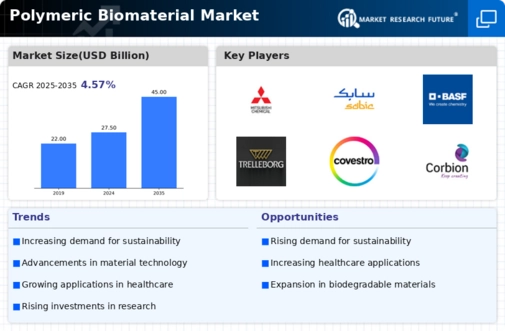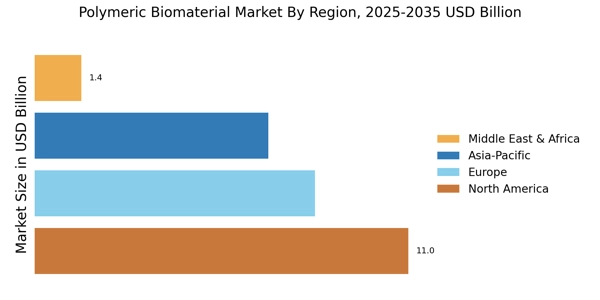Increasing Healthcare Expenditure
The rise in healthcare expenditure across various regions is propelling the growth of the Polymeric Biomaterial Market. As nations invest more in healthcare infrastructure and services, the demand for advanced medical devices and implants is escalating. This trend is reflected in the projected increase in healthcare spending, which is expected to reach over 10 trillion USD by 2025. Consequently, the need for high-performance biomaterials that can be used in surgical applications, drug delivery systems, and tissue engineering is becoming more pronounced. The Polymeric Biomaterial Market is poised to benefit from this surge, as healthcare providers seek innovative solutions that enhance patient care and operational efficiency. This growing investment in healthcare not only supports the development of new products but also encourages collaboration between manufacturers and healthcare professionals.
Rising Demand for Biodegradable Materials
The increasing awareness regarding environmental sustainability is driving the demand for biodegradable materials in the Polymeric Biomaterial Market. As consumers and industries alike seek alternatives to traditional plastics, biodegradable polymers are gaining traction. This shift is evidenced by a projected growth rate of approximately 12% annually in the biodegradable polymer segment. Companies are investing in research and development to create innovative materials that decompose naturally, thus reducing landfill waste. The Polymeric Biomaterial Market is witnessing a surge in applications across various sectors, including packaging, agriculture, and medical devices, where eco-friendly solutions are becoming a priority. This trend not only aligns with global sustainability goals but also presents lucrative opportunities for manufacturers who can adapt to these changing consumer preferences.
Growing Applications in Regenerative Medicine
The growing applications of polymeric biomaterials in regenerative medicine are significantly influencing the Polymeric Biomaterial Market. As the field of regenerative medicine advances, the demand for materials that can support tissue regeneration and repair is increasing. Polymeric biomaterials are being utilized in various applications, including scaffolds for tissue engineering, drug delivery systems, and wound healing products. The market is projected to grow at a rate of approximately 9% as researchers and clinicians explore new ways to harness the properties of these materials for therapeutic purposes. This trend is indicative of a broader shift towards personalized medicine, where polymeric biomaterials play a pivotal role in developing tailored treatment solutions. The Polymeric Biomaterial Market is thus positioned to benefit from the ongoing research and innovation in this dynamic field.
Regulatory Support for Biocompatible Materials
Regulatory support for biocompatible materials is a crucial driver for the Polymeric Biomaterial Market. Governments and regulatory bodies are increasingly recognizing the importance of biocompatibility in medical applications, leading to the establishment of guidelines and standards that promote the use of safe and effective biomaterials. This regulatory framework is fostering innovation and encouraging manufacturers to invest in the development of new polymeric materials that meet stringent safety requirements. As a result, the market is expected to expand, with a projected growth rate of around 8% over the next few years. The Polymeric Biomaterial Market is likely to see a rise in collaborations between regulatory agencies and industry stakeholders, ensuring that new products are not only effective but also compliant with safety standards, thereby enhancing consumer confidence.
Technological Advancements in Material Science
Technological advancements in material science are significantly influencing the Polymeric Biomaterial Market. Innovations in polymer synthesis and processing techniques are enabling the development of advanced biomaterials with enhanced properties. For instance, the introduction of 3D printing technology has revolutionized the production of customized polymeric implants and prosthetics, allowing for tailored solutions that meet specific patient needs. The market is expected to grow at a compound annual growth rate of around 10% due to these advancements. Furthermore, the integration of smart materials that respond to environmental stimuli is opening new avenues for applications in the medical field. As research continues to evolve, the Polymeric Biomaterial Market is likely to see a proliferation of novel products that enhance patient outcomes and improve the quality of life.


















Leave a Comment